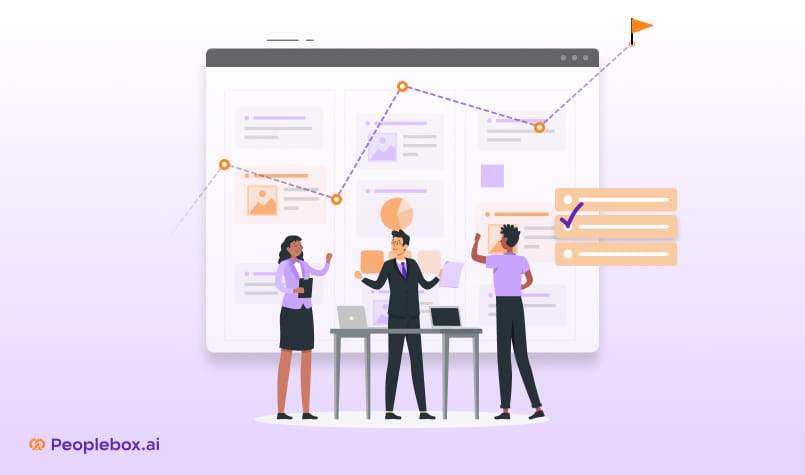Losing $15,000 on a single bad hire? – Worse than a nightmare! 👎
According to the United States Department of Labor, a poor hiring choice can cost as much as 30% of an employee’s first-year salary. For a $50,000 salary, that’s $15,000 down the drain.
For this reason alone, renowned companies like Google have implemented a rigorous process that includes assessments, short virtual chats, project work, and interviews. The result? A workforce of top-tier talent.
A well-drafted hiring process checklist can make all the difference. It guarantees consistency among candidates, lessens unconscious prejudice, and eventually improves hiring decisions. A step-by-step guide to creating a hiring process checklist includes,
- Identifying the need
- Developing a recruitment strategy
- Sourcing candidates
- Screening applicants
- Conducting interviews
- Assessing candidates
- Making a job offer
- Onboarding the new hire
We’ll explain the nitty-gritty of all steps in here and as a bonus added an instant hiring process checklist at the end.
What is a Hiring Process Checklist and Why Do You Need One?
A hiring process checklist is a structured document outlining key steps in recruitment, from job requisition to onboarding. It serves as a standardized protocol for HR professionals and hiring managers, ensuring compliance with employment laws and maintaining consistency across all candidates.
By following this guide, HR teams can optimize their talent acquisition efforts, mitigate legal risks, and improve the quality of hires while maintaining a fair and transparent recruitment process.
But why invest time in creating and maintaining such a checklist? Let’s break down the benefits of a hiring checklist:

1. Simplify hiring
A well-designed checklist can greatly simplify your hiring process. It helps your team get through each phase more quickly by eliminating guesswork and saving time on decision-making.
2. Help teams stay aligned
A shared checklist keeps every team member involved in hiring aligned. It establishes a single reliable source, decreasing room for misunderstanding and clarifying everyone’s contributions. This alignment reduces time to hire, a critical metric in recruitment success.
3. Promote fairness
A standardized process ensures each candidate receives equal consideration. That means more fairness and less bias in hiring. It not only improves the candidate experience but also helps build a diverse workforce.
4. Ensure compliance
The checklist meets all regulations and company policies. It also creates an audit trail of your hiring practices, supporting any legal scrutiny.
5. Optimize selection
With a defined hiring process checklist, you track metrics like time-to-fill, cost-per-hire, and offer acceptance rates. This data-driven approach enables continuous refinement of your hiring process, keeping it agile and effective.
Creating a Hiring Process Checklist – A Step By Step Guide
Here is a comprehensive framework of the hiring process checklist; feel free to tailor this checklist to your specific software, systems, processes, and strategic goals.
Step 1: Identify the need
First, identify your organization’s recruitment needs.
Studies reveal that a bad hire can cost your company up to $240,000. These mis-hires can have far-reaching consequences for your company’s culture and morale, impacting operations even after the person has quit. So it’s not only about the money.
Conversely, knowing what you need from a workforce positions your company better and safer. With this clarity, you can minimize your time to hire and increase your company’s production.
So, how do you go about identifying your hiring needs effectively?
Start by developing a skills-based Ideal Candidate Profile (ICP). This profile should focus on
- Hard skills: Technical abilities required for the role
- Soft skills: Interpersonal and adaptability traits
- Motivation: What drives the ideal candidate?
💡Remember, while it might be tempting to include requirements like past work experience or educational background, this can unnecessarily limit your talent pool and may even lead to unintended discrimination.
It is also worthwhile to carry out an internal skills audit. Evaluate the present team’s strengths and weaknesses and fill up any knowledge gaps you find. Sometimes, these gaps can be filled by upskilling existing employees rather than hiring new ones.
Lastly, take stock of your capacity and workload. Can someone on a contract or part-time basis fill this role, or is full-time employment required? Is the workload expected to be short-term or long-term? This understanding will lead you to our next step.
Step 2: Develop a recruitment strategy
Post-hiring needs, it’s time to build a robust strategy for recruitment. A recruitment strategy outlines
- The company’s general hiring practices
- Its application of social media and technology
- Internal mobility
- Possibilities of outsourcing.
It may also contain details about employer branding, employing a diverse staff, and ranking potential openings.
Here’s how to create a recruitment strategy that really delivers:
✔ Get in sync with your company’s big picture: What’s your company aiming for in the next few years? Maybe you’re planning to expand into new markets or launch a game-changing product. Your recruitment strategy needs to support these goals.
✔ Show off what makes you special: Every company has its own personality. What’s yours? Let potential candidates know what sets you apart, whether it’s your innovative culture, commitment to work-life balance, or mission to change the world.
✔ Open doors for everyone: Diversity isn’t just a buzzword—it’s a business advantage. Consider how you can reach out to different communities and create an inclusive hiring process.
✔ Embrace the tech revolution: There are some amazing tools out there that can make your hiring process smoother and smarter. Don’t be afraid to try out AI-powered screening or video interviewing platforms.
✔ Look inside and outside: Sometimes, the perfect candidate is already working for you. Other times, you need fresh perspectives from outside. Strike a balance that works for your company.
✔ Think beyond full-time: Today’s workforce is diverse. Consider how you’ll approach hiring freelancers, remote workers, or part-time staff.
✔ Set goals you can measure: How will you know if your strategy is working? Set clear, measurable targets and keep track of your progress.
✔ Build for the future: Don’t just focus on immediate openings. Build relationships with potential candidates for roles you might need to fill down the road.
💡You must consider employing an applicant tracking system (ATS) to improve hiring by automating tasks like organizing resumes and scheduling interviews. It also improves recruiting by screening efficiently, guarantees compliance, and gives useful insights for improving recruitment steps. An ATS is a must-have for productive and efficient talent acquisition.
Step 3: Source candidates
Candidate sourcing means actively looking for people who are fit to perform the job. This is how your team meets with potential new hires who could end up in your talent pipeline for immediate and future openings.
Don’t put all your eggs in one basket when finding great candidates. While 52% of recruiters start with their professional networks, 28% turn to LinkedIn first. However, limiting yourself to these channels might mean missing out on top talent.
The key is to diversify your sourcing strategy based on the role you’re filling. Here’s how to broaden your approach:
- Tailor your approach: Different roles require different sourcing tactics. For freelancers, consider niche sites like ProBlogger, where these professionals often search for opportunities. For part-time roles, local job boards or community groups might be more effective.
- Don’t overlook passive candidates: Some of the best talent isn’t actively job hunting. Use social media to identify potential candidates based on skills and experience.
- Utilize employee referrals: Your current team members can be excellent talent scouts. Set up a structured referral program to encourage this.
- Attend (or host) industry events: Whether virtual or in-person, these gatherings are great for connecting with potential candidates who are engaged in your industry.
Step 4: Screen applicants
After sourcing your candidates from different platforms, you must now sit through the screening process. Here’s how to do it effectively:
- Resume and cover letter review: Look beyond just skills and experience. Pay attention to formatting, unexplained gaps, and overall presentation. These can offer insights into a candidate’s attention to detail and communication skills.
- Use targeted application questions: Incorporate open-ended questions in your application process. This can reveal a candidate’s motivation, career goals, and how they perceive their fit for the role.
- Consider video applications: Short video introductions can provide a more personal glimpse into a candidate’s communication style and enthusiasm for the role.
- Conduct phone screenings: Use these to verify basic information and assess communication skills. Be alert to red flags like no-shows, application inconsistencies, or lack of engagement.
- Implement skills assessments: Use job-relevant tests to evaluate candidates’ abilities objectively. This could include aptitude tests, coding challenges, or role-specific simulations.
- Personality assessments: These can help gauge cultural fit and identify behavioral traits crucial for the role.
- Background checks and references: Verify credentials and get insights from previous employers. Ensure you comply with legal requirements when conducting these checks.
💡As for those you’re not moving forward with, be sure to part on good terms. Let them know that while they weren’t the right fit for this particular role, they’re still valued for future opportunities. Invite them to join your talent community to stay connected. Keeping this line of communication open can turn today’s no into tomorrow’s yes.
Step 5: Conduct interviews
Interviews are your chance to truly get to know your candidates. Here’s how to make them count:
✔ Start with thorough preparation. Define the role requirements clearly and build a structured interview script. Include a mix of questions – icebreakers, role-specific queries, and behavioral questions using the STAR method (Situation, Task, Action, Result).
✔ It’s important to frame your company in a good light and avoid negatively phrased questions. Remember, you’re not just evaluating candidates but also promoting your company to potential employees.
✔ Take notes during the interview or use AI note-taking tools to capture important details. These will be invaluable when comparing candidates later.
✔ After the interview is over, give the candidates a chance to ask questions. This shows their level of interest and preparation. Finally, communicate the next steps in the hiring process.
💡When interviewing, try to maintain an 80/20 rule: focus on listening(80% of the time) and speaking (20%) only when absolutely necessary. This allows candidates to express themselves fully. Pay attention to nonverbal cues as well — they often speak volumes.
Step 6: Assess candidates
Once interviews wrap up, it’s crucial to capture your interview team’s fresh insights. Encourage them to complete their candidate evaluation forms promptly. This is when their memories are sharpest and their impressions most accurate.
Use specialized software to keep every evaluation organized and accessible. It can streamline your review process, making it easier to compare candidates side-by-side. If the decision isn’t immediately clear, why not gather the team for a quick debrief?
This can be a great way to pool thoughts and perspectives so no detail is overlooked. Together, you can decide which candidates are ready to move forward.
Step 7: Make a job offer
Let’s say you’ve found your ideal candidate. Now, it’s time to seal the deal with a compelling job offer. Here’s how to navigate this:
Crafting a competitive offer package: Start by researching current market rates for the role. Your offer should align with or exceed these benchmarks. Consider the candidate’s experience and the value they’ll bring to your organization. Remember, a competitive package isn’t just about salary. Include details on benefits, stock options, bonuses, and perks that set your company apart.
Negotiating salary and benefits: Be prepared for negotiations. Have a salary range in mind, but remain flexible. Listen to the candidate’s expectations and be ready to justify your offer. If you can’t deliver on their pay demands, think about other ways to compensate them, such as giving them more vacation time, letting them set flexible hours, or giving them chances to grow professionally.
Handling counteroffers: If your chosen candidate receives a counteroffer from their current employer, don’t panic. Instead, reiterate the unique value proposition of your role and company. Highlight growth opportunities, company culture, and how the position aligns with their career goals. If you decide to match or exceed the counteroffer, ensure it doesn’t create internal equity issues.
When making the offer:
- Act quickly once you’ve decided.
- Deliver the offer verbally first, followed by a written offer.
- Clearly communicate all components of the package.
- Set a deadline for the candidate’s decision, typically 3-5 business days.
- Be enthusiastic – show them you’re excited about the prospect of them joining your team.
💡According to research, prospects find that waiting for a recruiter’s response following an interview is the most annoying aspect of the job hunt. Never let a candidate go for over a week without any communication, even if it’s only to inform them that you are still making a final decision.
Step 8: Onboarding the new hire
Research shows that 51% of employees are more likely to go above and beyond when they have a positive onboarding experience. So, how do you offer your candidates such an onboarding experience?
Start with a clear roadmap – First things first: write out a comprehensive job description that spells out everything you can anticipate doing in your first three months on the job. Pair this with measurable performance metrics to give your new hire a clear picture of what success looks like in their role.
Implement a progressive training schedule – Design a schedule combining on-the-job learning, workshops, and mentorship. Remember, every new employee learns at their own pace, so be ready to adjust as needed. Regular check-ins are crucial – schedule weekly meetings to assess progress and address any challenges head-on.
Encourage team bonding – Integrating new hires into the team is just as important as teaching them their role. Organize team-building activities and pair them with experienced mentors. Inspire new points of view at team meetings and cultivate an atmosphere where everyone feels comfortable sharing their ideas.
💡When things don’t go as planned, look for signs that your onboarding might not be hitting the mark. If you notice underperformance or disengagement, don’t hesitate to revisit key aspects of the process. Research shows that re-onboarding can significantly improve focus, productivity, and retention.
Your Instant Hiring Process Checklist
Now, you know how to create a hiring process checklist from scratch. However, to get you started, we have a ready-made checklist you can start using right away.
Note: Specific steps may vary based on the company size, industry, and job role. You must tailor the process to your organization’s unique needs.
Wrapping Up
Building exceptional teams comes with a robust hiring process. And by using our detailed hiring process checklist, your HR team will not just fill positions but find the right fit every time.
Remember, the world of work is constantly evolving, and your hiring process should, too. Stay updated on industry trends and candidate expectations. Be sure to review your checklist on a regular basis and make any necessary modifications.
Keep it simple, make it smart, and let every step in your hiring checklist reflect your commitment to bringing in the best.







